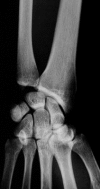SAPHO Syndrome Diagnosis and Treatment: Report of Five Cases and Review of the Literature
- PMID: 19997538
- PMCID: PMC2790148
- DOI: 10.2174/1874325000903010100
SAPHO Syndrome Diagnosis and Treatment: Report of Five Cases and Review of the Literature
Abstract
Background: The term "SAPHO (Synovitis, Acne, Pustulosis, Hyperostosis and Osteitis) syndrome" includes a variety of musculoskeletal disorders associated with skin conditions; Osteitis is the most prominent skeletal lesion, whereas palmoplantar pustulosis and acne are the main skin lesions. Diagnosing SAPHO syndrome is difficult, because this syndrome is often confused with suppurative osteomyelitis, which has similar clinical and pathologic findings. SAPHO diagnosis is even more difficult when atypical sites are involved and there are no skin lesions.
Patients and methods: This case series presents five patients (3 women, 2 men), ages 27 to 44 years, who came to the Orthopaedic Department outpatient clinic for evaluation of pain in the humerus, clavicle, sacroiliac joints, and/or distal radius, and were diagnosed with SAPHO syndrome. Clinical and radiologic findings, treatment and outcome data, with up to 4 years of follow-up are presented. An extensive discussion of the clinical presentation, published literature, treatment options and outcome of SAPHO syndrome is also included.
Results: Once the diagnosis of SAPHO syndrome was established, treatment with antibiotics (clindamycin) and non steroid anti-inflammatory drugs (lornoxicam) was remarkably effective. All patients did well and remained symptom free for up to four years, after a 3-8 month course of treatment.
Interpretation: SAPHO syndrome should be included in the differential diagnosis when evaluating patients with lytic, sclerotic, or hyperostotic bone lesions and pain. Prompt SAPHO syndrome recognition, followed by appropriate therapy with antibiotics and NSAIDs can produce rapid symptom resolution, while avoiding unnecessary procedures and longterm antibiotic therapy.
Keywords: SAPHO; acne; clindamycin.; hyperostosis; lornoxicam; osteitis; pain; pustulosis; synovitis.
Figures





References
-
- Suei Y, Taguchi A, Tanimoto K. Diagnostic points and possible origin of osteomyelitis in synovitis, acne, pustulosis, hyperostosis and osteitis (SAPHO) syndrome: A radiographic study of 77 mandibular osteomyelitis cases. Rheumatology (Oxford) 2003;42:1398–403. - PubMed
-
- Chamot AM, Benhamou CL, Kahn MF, Beraneck L, Kaplan G, Prost A. Acne-pustulosis-hyperostosis-osteitis syndrome. Results of a national survey 85 cases. Rev Rhum Mal Osteoartic. 1987;54:187–96. - PubMed
-
- Hayem G, Bouchaud-Chabot A, Benali K, et al. SAPHO syndrome: a long-term follow-up study of 120 cases. Semin Arthritis Rheum. 1999;29:159–71. - PubMed
-
- Boutin RD, Resnick D. The SAPHO syndrome: An evolving concept for unifying several idiopathic disorders of bone and skin. AJR Am J Roentgenol. 1998;170:585–91. - PubMed
-
- Earwaker JW, Cotton A. SAPHO: Syndrome or concept? Imaging findings. Skeletal Radiol. 2003;32:311–27. - PubMed
LinkOut - more resources
Full Text Sources
